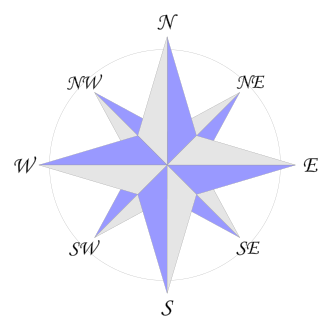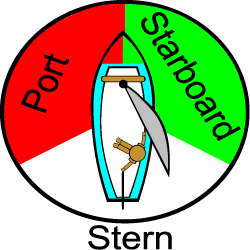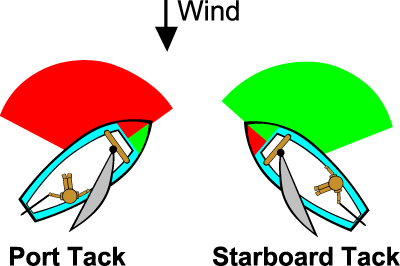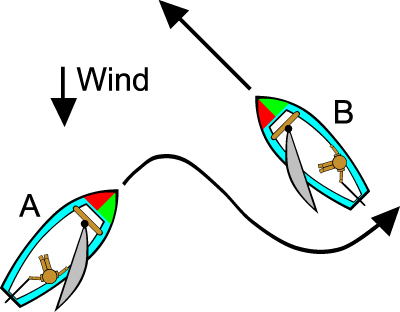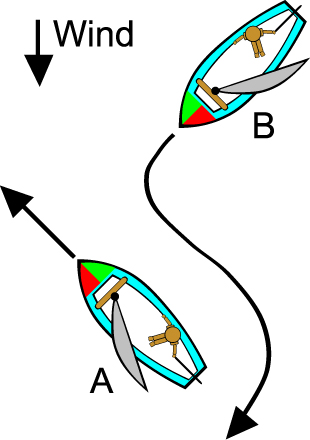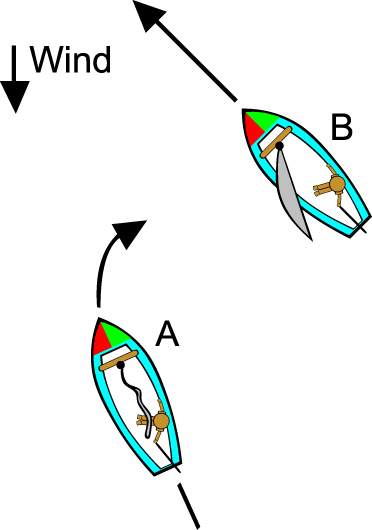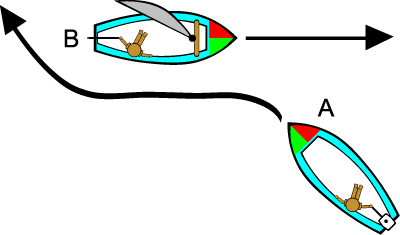Difference between revisions of "AY Honors/Navigation/Answer Key/es"
(Created page with "{{clear}}") |
(Created page with "{{clear}}") |
||
| Line 34: | Line 34: | ||
{{clear}} | {{clear}} | ||
| − | + | {{clear}} | |
| − | |||
| − | |||
| − | |||
<noinclude></noinclude> | <noinclude></noinclude> | ||
Revision as of 01:37, 31 January 2021
| Navegación | ||
|---|---|---|
| Asociación General
|
Destreza: 2 Año de introducción: 1953 |
|
Requisitos
|
La especialidad de Navegación es un componente de la Maestría Acuática. |
1
2
3
4
Buoys used to mark the edges of channels:
- a. Nun buoys
- painted red with even numbers.
- b. Can buoys
- painted green with odd numbers.
- c. Spar buoys
- are painted red with even numbers and black with odd numbers. When entering a harbor, keep red buoys to starboard, and black buoys to port.
Buoys used to mark obstructions, anchorage, fishing nets, and fairways:
- a. Mid-channel buoys
- have a white light and have white and black vertical stripes. They show the direction to the harbor.
- b. Fairway buoys
- may be of any shape. They are painted black and white vertical stripes. These buoys mark the center of a channel or fairway and should be passed close aboard on either hand.
- c. Anchorage buoys
- are always white and mark where an anchorage may be made.
5
"Boxing a compass" means to name the points on the compass in a clockwise order starting with north. With eight cardinal points, this would be:
- north
- northeast
- east
- southeast
- south
- southwest
- west
- northwest.
The compass is used along with a geometry compass, dividers, parallel rules, a straightedge, and a protractor to find the boat’s position on charts. When the sky is overcast and there is no land in sight, it is very easy to get disoriented. The compass will keep you on course and help you find your way back to port. Compasses are meant to be mounted on bulkheads, atop consoles, gimbals, or brackets. Some are flushed and mounted. Flush mounts are better because they transmit less vibration than a bracket-mount compass. The compass should have a guard to protect it from damage and a hood to eliminate sun glare.
6
Adventist Youth Honors Answer Book/Knot/Two half hitches
Adventist Youth Honors Answer Book/Knot/Bowline
Adventist Youth Honors Answer Book/Knot/Figure 8
Adventist Youth Honors Answer Book/Knot/Mooring Hitch
Adventist Youth Honors Answer Book/Knot/Sheetbend
7
8
- Stay alert to nearby vessels, hazards and changing weather conditions. Refrain from substances or practices that could impair judgment or alertness (e.g. alcohol, lack of sleep).
- Travel at safe and appropriate speeds.
- Follow the "rules of the road."
9
A properly equipped boat has on it:
Appropriate sized life preservers for all aboard. Button, zip and strap up all of the closures of the lifejacket.. The jacket should be snug but not so tight that you can’t breathe. Lift your arms in the air. Make an eleven with your arms, the universal football touchdown sign, and put your hands straight up in the air. If the life jacket does not rise, it’s a good fit. Follow this rule for adults and children. (Could draw a person with their arms raised up and the lifejacket fitting snuggly to body, not moving upward.)
A fire extinguisher classified for the type of fire its designed to extinguish. A 'Class B' Fire Extinguisher will be needed on the vessel. This type of extinguisher is for gasoline, oil, paint and other flammable liquids. The extinguisher will contain foam, ABC powder or carbon dioxide to put out the fire.
A properly ventilated fuel tank and engine room At least 2 ventilator ducts fitted with cowls of for the purpose of properly and efficiently ventilating the bilges of every inboard engine and fuel tank compartment of boats constructed or decked over after April 25, 1940, using gasoline or other fuel having a flashpoint less than 110 F. Boats built after 31 July 1980 must have operable power blowers.
A whistle, bell or horn. Any Device capable or making an "efficient sound signal" audible for 1/2 mile.
Visual distress signals. Required only when operating at night (N). Some night equipment choices as for larger boats including: Orange Flag with Black Square-and-disc (day); and an S-O-S electric light (night); or 3 orange smoke signals, hand held or floating (day); or 3 red flares of handheld, meteor, or parachute type (day/night).
Navigational lights to be displayed between dusk and dawn. Recreational boats operating at night are required to display navigation lights between sunset and sunrise.
10
For the purposes of the sailing honor we will focus in the rules of the road that apply to small sailing boats.
It is important to note here that you are responsible for learning the rules and regulations that apply to whichever boat you are operating in the country and state or province where you are operating the boat.
There are five basic rules of the road for small sailing boats to decide who has the "Right-of-Way" so that each boat's skipper (driver) will know what to do to avoid a collision.
When sailing the words "left" and "right" in reference are replaced with "port" and "starboard". It is important to remember which is which since the rules of the road for sailing rely on using these words to assign right-of-way.
You might be able to remember this by noticing that the letter "R" appears twice in the word "starboard", and only once in "port". Then since "right" begins with "R", you will know that the right hand side of the boat when facing forward is the starboard side.
The next item to remember is the word "tack" and how it is used to describe which side of the boat the wind is blowing from. As seen in the illustration below, if the wind is coming from the right hand side of the boat, and the sail is on the left side, the boat is on a starboard tack. When the wind and sail are reveresed, the boat is on a port tack.
Rule Number 1:
When two sailboats are approaching each other and are on different tacks, the boat on the starboard tack has the right-of-way over the boat which is in the port tack. An easy way to remember this is to think about power boat lights. At the front the boat has red on the port (left side) and green to the starboard (right). If you are approaching a boat and can "see" the red light, then the other boat has the right of way. (small sail boats rarely have the actual lights, but you can imagine them)
In the illustration below, boat "A" on the port tack, must turn to avoid boat "B" on the starboard tack.
Rule Number 2:
When two sailboats are approaching each other and are on the same tack, the leeward boat has the right-of-way over the windward boat. Another way to say this is to say that the boat closer to the wind source must keep clear. The boat further from the wind source has the right-of-way.
In the illustration below, boat "B" is the windward boat and must turn to avoid boat "A" which is leeward.
Rule Number 3
A sailboat that is staying on a tack has the right-of-way over a sailboat that is tacking or gybing. A simpler way to say this is to say "make sure you have room to complete a tack or a gybe without interfering with any other boats before doing so". Make sure that you can see clearly in all directions to ensure you have room.
In the illustration below, boat "A" must ensure that it leaves plenty of room to avoid boat "B", who has the right-of-way, since boat "B" is continuing on its tack. However, in the event that boat "A" was unable to tack due to the proximity of "B", remember that "A" is the leeward boat so therefore could tell boat "B" to give room to tack, but would lose this right of way as soon as they actually began to tack.
Rule Number 4
Any sailboat that is overtaking a slower boat from behind must steer clear of the slower boat and give right-of-way. The slower boat should hold its course and allow the faster boat to pass.
In the illustration below, boat "A" is a faster boat, and must steer around the slower boat "B", who should remain on the same course.
Rule Number 5
Most of the time sailboats have the right-of-way over power boats. Since most powerboats are more easily maneuverable than sailboats, they must steer clear. This is not always the case however. Larger power boats are sometimes steering in the deep channel of the area, and cannot leave the channel. In this case the sailboat does not have right-of-way, and must avoid impeding the progress of the larger vessel. Many larger power boats cannot simply stop quickly or easily turn to avoid a small sailboat, so it is in the sailor's best interest to steer well clear of these larger boats.
In the illustration below, the powerboat "A" must turn to avoid the sailboat "B", who has the right-of-way.
References
- Categoría: Tiene imagen de insignia
- Categoría:Libro de Respuestas de Especialidades JA/Especialidades
- Categoría:Libro de Respuestas de Especialidades JA
- Categoría:Libro de Respuestas de Especialidades JA/Nivel de Destreza 2
- Categoría: Libro de respuestas de especialidades JA/Especialidades introducidas en 1953
- Categoría:Libro de Respuestas de Especialidades JA/Asociación General
- Adventist Youth Honors Answer Book/Recreation/es
- Adventist Youth Honors Answer Book/Recreation/Primary/es
- Categoría:Libro de Respuestas de Especialidades JA/Etapa 0
- Adventist Youth Honors Answer Book/Aquatic Master Award/es
- Adventist Youth Honors Answer Book/Prerequisite/Weather/es
- Adventist Youth Honors Answer Book

